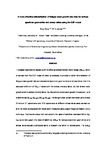A more effective rationalisation of fatigue crack growth rate data for various specimen geometries and stress ratios using the CJP model
| dc.contributor.author | Yang, B | |
| dc.contributor.author | Vasco-Olmo, JM | |
| dc.contributor.author | Díaz, FA | |
| dc.contributor.author | James, Neil | |
| dc.date.accessioned | 2018-08-03T16:43:50Z | |
| dc.date.issued | 2018-09 | |
| dc.identifier.issn | 0142-1123 | |
| dc.identifier.issn | 1879-3452 | |
| dc.identifier.other | C | |
| dc.identifier.uri | http://hdl.handle.net/10026.1/11986 | |
| dc.description | publisher: Elsevier articletitle: A more effective rationalisation of fatigue crack growth rate data for various specimen geometries and stress ratios using the CJP model journaltitle: International Journal of Fatigue articlelink: https://doi.org/10.1016/j.ijfatigue.2018.05.027 content_type: article copyright: © 2018 Elsevier Ltd. All rights reserved. | |
| dc.description.abstract |
This paper demonstrates that the CJP model of crack tip stresses, through its ability to directly predict the effective range of stress intensity factor, also provides an improved rationalisation of fatigue crack growth rate across several different specimen geometries and stress ratios. This aim is achieved through a comparison between the crack growth rate rationalisation obtained using the CJP stress intensity factor range, ΔKCJP, and that derived from the standard Irwin definition of ΔK = Kmax − Kmin. The results demonstrate a significant improvement arising from the use of the CJP stress intensity factors and also highlight the fact that the CJP crack tip field model does not require the incorporation of compliance-based geometry-correction factors in the calculation of stress intensity. Fatigue crack growth rate tests were carried out on compact tension (CT) and double edge-notched tension (DENT) specimens of Grade 2 titanium at various stress ratios between 0.05 and 0.6 whilst making simultaneous crack tip displacement field measurements using the digital image correlation (DIC) technique. The DIC data were then processed to obtain the CJP stress intensity factors KF and KR. Calculation of the CJP stress intensity factors is relatively complex and rests on the acquisition of displacement field data. In order to facilitate simplified prediction of crack growth rates using the CJP model, this paper also determines a relationship between ΔKCJP and ΔK using calibration curves that relate the values of the parameters in the CJP model to the standard ΔK value. | |
| dc.format.extent | 189-197 | |
| dc.language | en | |
| dc.language.iso | en | |
| dc.publisher | Elsevier | |
| dc.subject | CJP model | |
| dc.subject | Crack tip displacement fields | |
| dc.subject | Digital image correlation | |
| dc.subject | Effective stress intensity factor | |
| dc.subject | Fatigue crack growth rate | |
| dc.title | A more effective rationalisation of fatigue crack growth rate data for various specimen geometries and stress ratios using the CJP model | |
| dc.type | journal-article | |
| dc.type | Journal Article | |
| plymouth.author-url | https://www.webofscience.com/api/gateway?GWVersion=2&SrcApp=PARTNER_APP&SrcAuth=LinksAMR&KeyUT=WOS:000441487100019&DestLinkType=FullRecord&DestApp=ALL_WOS&UsrCustomerID=11bb513d99f797142bcfeffcc58ea008 | |
| plymouth.volume | 114 | |
| plymouth.publication-status | Published | |
| plymouth.journal | International Journal of Fatigue | |
| dc.identifier.doi | 10.1016/j.ijfatigue.2018.05.027 | |
| plymouth.organisational-group | /Plymouth | |
| plymouth.organisational-group | /Plymouth/Faculty of Science and Engineering | |
| plymouth.organisational-group | /Plymouth/Faculty of Science and Engineering/School of Engineering, Computing and Mathematics | |
| plymouth.organisational-group | /Plymouth/Users by role | |
| plymouth.organisational-group | /Plymouth/Users by role/Academics | |
| dcterms.dateAccepted | 2018-05-25 | |
| dc.rights.embargodate | 2019-5-26 | |
| dc.identifier.eissn | 1879-3452 | |
| dc.rights.embargoperiod | Not known | |
| rioxxterms.versionofrecord | 10.1016/j.ijfatigue.2018.05.027 | |
| rioxxterms.licenseref.uri | http://www.rioxx.net/licenses/all-rights-reserved | |
| rioxxterms.licenseref.startdate | 2018-09 | |
| rioxxterms.type | Journal Article/Review |


